Setting up TPM 2.0 (Trusted Platform Module) and Secure Boot on a Gigabyte motherboard is a key step for those who want to keep their computer secure and ready for the latest software demands. These features are vital for anyone who uses their computer for more than just browsing the web, especially gamers. For example, Riot’s popular game “Valorant” requires both TPM 2.0 and Secure Boot to be activated to even start the game. In this article, we’ll guide you through each step to turn on TPM 2.0 and Secure Boot in a Gigabyte motherboard.
Also see: How to Enable TPM 2.0 and Secure Boot on ASRock
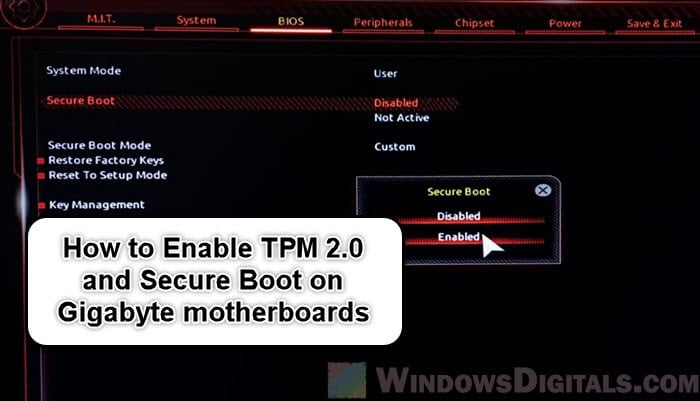
Why TPM 2.0 and Secure Boot have become essential?
In today’s digital age, the security of our computers is more important than ever. This is where TPM 2.0 and Secure Boot come into the picture. But why have these features become so crucial now?
TPM 2.0: Trusted Platform Module (TPM) 2.0 is a hardware-based security feature that provides a secure environment for your computer. It’s like having a dedicated security guard for your system. This chip handles cryptographic operations, protecting your data and making sure your computer starts up with trusted hardware only. With the rise in cyber threats and data breaches, TPM 2.0 acts as a first line of defense, safeguarding sensitive information from being compromised.
Secure Boot: Secure Boot is a feature in your computer’s UEFI (the modern replacement for BIOS) that ensures only trusted software is loaded during startup. It’s like a bouncer at the door of your computer, checking each piece of software before letting it run. This prevents malicious software, like viruses or ransomware, from sneaking in during the boot process.
These features are not just about security; they’re also about compliance and functionality. Many modern applications, especially games like Riot’s “Valorant,” require these security measures to run. They ensure the game runs in a secure environment, free from cheats or hacks that could ruin the gaming experience.
Learn more: Can’t find TPM 2.0 and Secure Boot options in BIOS?
Opening the UEFI Settings on a Gigabyte motherboard
The first step in enabling TPM 2.0 and Secure Boot on a Gigabyte motherboard is to access the UEFI settings. UEFI (Unified Extensible Firmware Interface) is the upgraded version of the old BIOS system, offering more features and a better interface. Here’s how you get into the UEFI settings:
- Begin by restarting your computer. The key to entering the UEFI settings is to press a specific key during the initial boot phase.
- As your computer restarts, keep an eye out for a message that indicates which key to press to enter the UEFI settings. On most Gigabyte motherboards, this is usually the Del key. Press it repeatedly as soon as your computer starts up. If you miss the correct timing and your operating system begins to load, don’t worry. Just restart and try again.
- Once you’ve successfully entered the UEFI settings, you’ll see a graphical interface. It’s much more user-friendly than the old BIOS interfaces. You’ll use your keyboard and possibly your mouse to navigate through various settings.
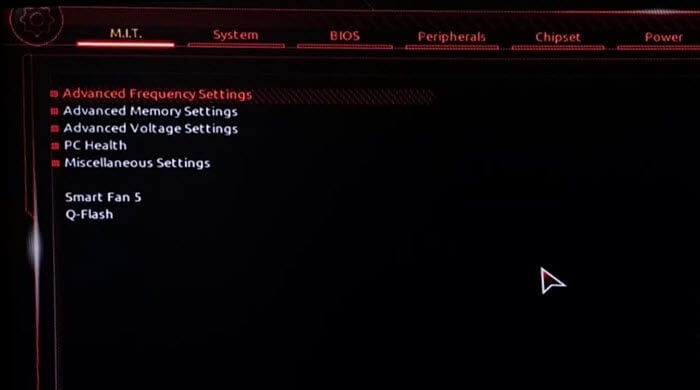
- “If you’re not seeing the screen as shown in the screenshot above, and you’re on the screen called “Easy Mode”, click on “Classic” or press F2.
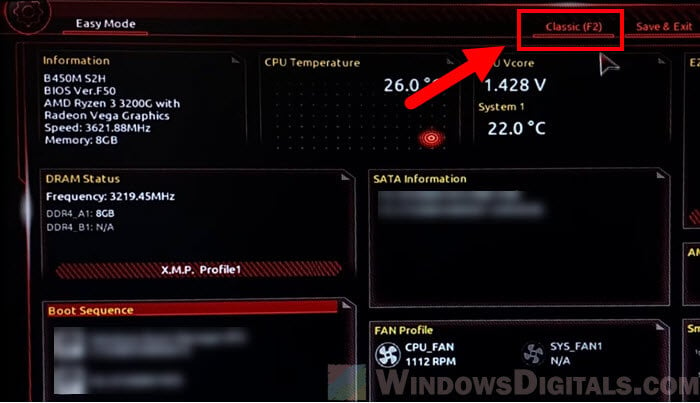
Remember, the UEFI interface can differ slightly depending on your specific Gigabyte motherboard model. If you find yourself unsure of where to go next, your motherboard’s manual is a great source of specific guidance.
Related resource: How to Uninstall & Disable Gigabyte App Center from BIOS
How to enable TPM 2.0 on a Gigabyte motherboard
Once you’re in the UEFI settings of your Gigabyte motherboard, it’s time to enable TPM 2.0. This security feature is vital for both system protection and compatibility with certain software and games, such as Riot’s “Valorant.” Here’s how you can turn on TPM 2.0:
- In the UEFI menu, look for a tab or option labeled “Peripherals“. It may also be called “Security,” “Advanced,” or something similar. This is usually where you’ll find the TPM settings. The exact location can vary, so if you’re having trouble finding it, a quick look at your motherboard’s manual can help.
- Within the “Peripherals” settings, you might see an option labeled as “AMD CPU fTPM”. It can also be labeled “TPM Device,” “TPM Security,” or “Intel PTT” (for Intel processors). Select this option and change it to “Enabled.”
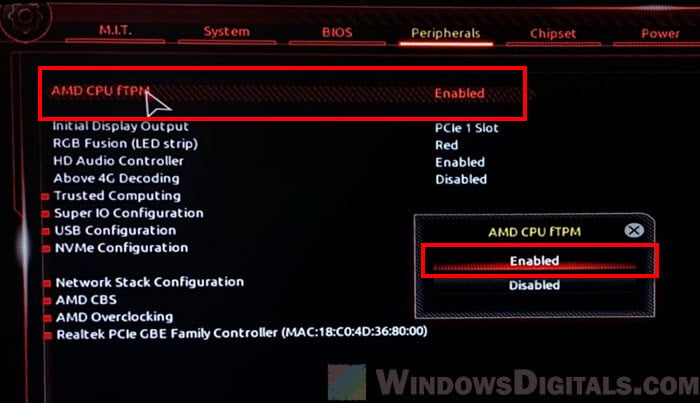
- After enabling TPM, proceed to the next section if you also need to enable Secure Boot. If TPM 2.0 is the only feature you’re activating, remember to save your changes. This is typically done by pressing F10 or selecting the “Save & Exit” option in the UEFI menu. Your computer will then reboot with TPM 2.0 enabled.”
Enabling TPM on some older Gigabyte motherboards might require a BIOS/UEFI firmware update. If TPM 2.0 is not available or not functioning on your motherboard, check for a firmware update on the Gigabyte website.
Pro tip: In-place Upgrade of Windows 11 on Unsupported Hardware
How to enable Secure Boot on a Gigabyte motherboard
After activating TPM 2.0, the next step is to enable Secure Boot on your Gigabyte motherboard. Secure Boot is a UEFI feature that ensures your PC boots using only software that is trusted by the motherboard manufacturer. This step is crucial for maintaining a secure system, especially if you’re running games like “Valorant” that require these security measures. Here’s how to enable Secure Boot:
- In the UEFI settings, look for the “BIOS” tab or a similarly named section.
- Within the BIOS options, locate the “CSM Support” setting and change it to “Disabled“.
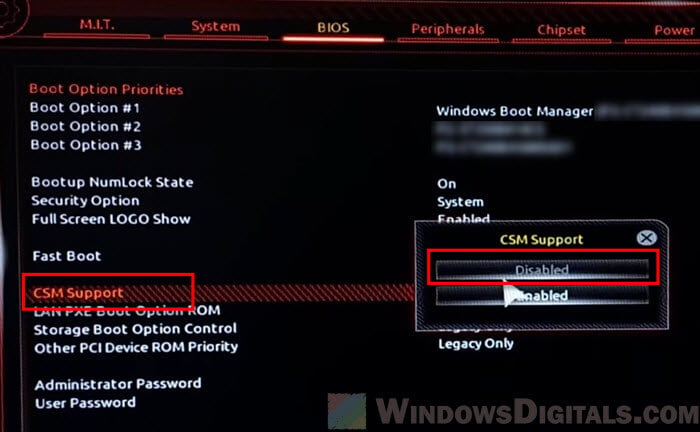
- The CSM Support setting needs to be disabled so that the Secure Boot option can appear.
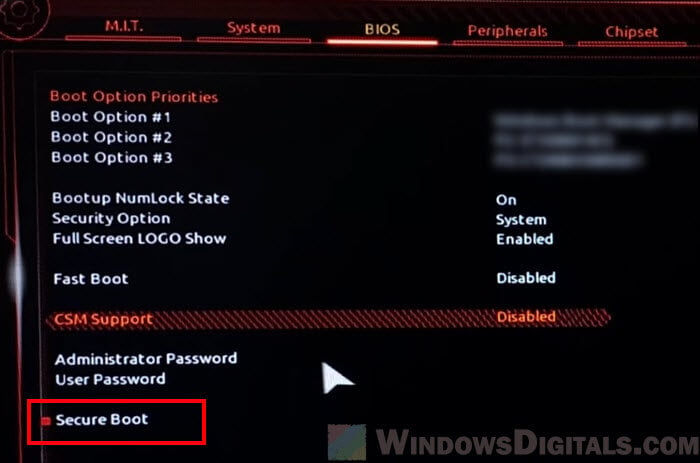
- Change the “Secure Boot” setting from “Disabled” to “Enabled“.
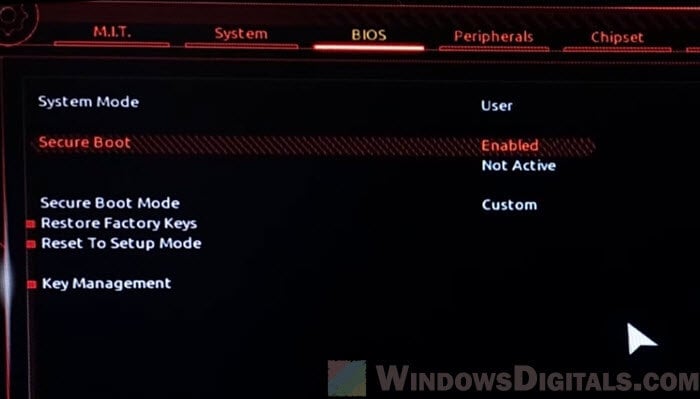
- If you cannot change the Secure Boot setting, save and exit, then restart your computer. Return to the same UEFI setting to enable it.
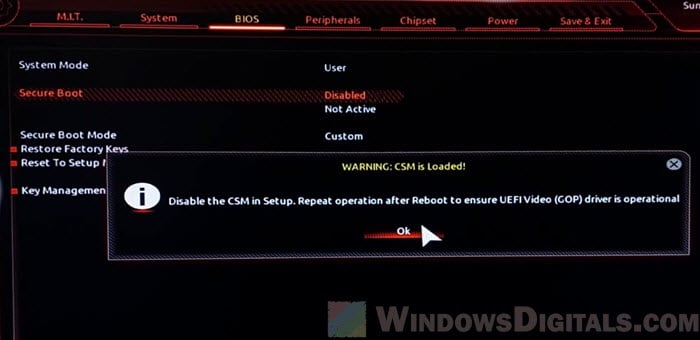
- Just like with the TPM setting, remember to save your changes. You can usually do this by pressing F10 or selecting “Save Changes and Exit” from the Exit menu. Your computer will reboot with Secure Boot enabled.
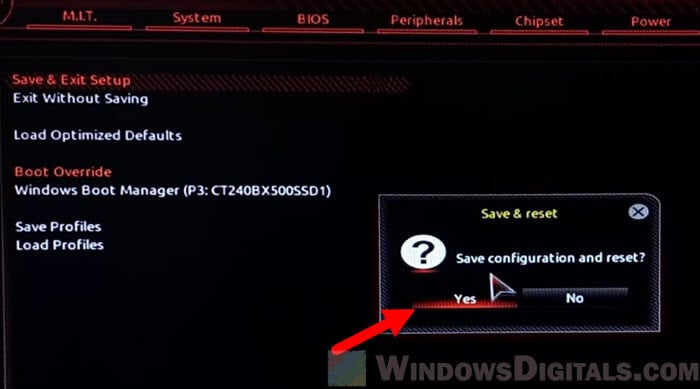
It’s important to note that turning on Secure Boot can sometimes cause issues with older operating systems or non-UEFI compliant software. If you’re using a dual-boot system or older software, make sure everything is compatible with Secure Boot before enabling it.
Linked issue: Virtualbox Windows 11: This PC doesn’t meet the requirements
Ensuring compatibility with gaming and modern software
One of the primary reasons to enable TPM 2.0 and Secure Boot on your Gigabyte motherboard is to ensure compatibility with modern software and games. This is particularly relevant for gamers. For instance, Riot Games’ “Valorant” is a popular title that requires these security features to be enabled for the game to run. This trend is not limited to gaming alone; many contemporary software applications leverage these security measures for enhanced protection.
Gaming Compatibility: Games like “Valorant” use TPM and Secure Boot to ensure a secure and fair gaming environment. These features help prevent cheating and hacking, which can ruin the gaming experience. By enabling these on your Gigabyte motherboard, you’re not just securing your system, you’re also ensuring that you won’t face issues when trying to run these games.
Software Security: Beyond gaming, TPM 2.0 and Secure Boot provide a foundation for secure computing, safeguarding your system from malware and unauthorized access. This is increasingly important in an era where security breaches are common.
By enabling these features, you’re aligning your system with the current standards for security and compatibility. It’s an essential step to make the most out of your computing experience, whether it’s for gaming, work, or everyday use.
Summing up
Turning on TPM 2.0 and Secure Boot in your Gigabyte motherboard isn’t just about getting ready for the next gaming session. It’s a lot like putting on a seatbelt before driving; it’s about safety. These steps are key not only for playing games like “Valorant” but also for keeping your whole system secure. It’s like having a strong lock on your door – it keeps the bad stuff out, whether it’s hackers or harmful software.
And it’s not just for gamers. With Windows 11 requiring these features, it’s clear that this is the way forward for all computers, whether it’s a desktop or a laptop. By enabling TPM and Secure Boot, you’re making sure your computer is up to date with the latest security standards. It’s a smart move, ensuring that your computer is safe, secure, and ready for whatever comes next, be it work, play, or anything in between.
